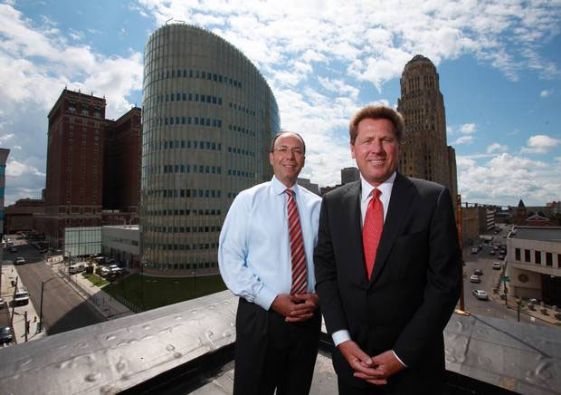Anthony Baynes, left, and Kent Frey stand on the roof outside a penthouse unit at 100 South, Buffalo’s former Corn Exchange Building.
Read the article on Buffalo News Web
Buffalo’s newest upscale loft apartments — the future home to several players from the Buffalo Sabres and Buffalo Bills — should be completed and open by Sept. 1, culminating a $5.5 million effort by the former chairman of the county control board and a prominent electrical contractor to bring a 95-year-old building back to life.
The revival of downtown Buffalo’s Corn Exchange Building is just the latest example of adaptive reuse of the city’s vintage buildings, turning aging and abandoned commercial or industrial space into vibrant residences that appeal to a the emerging population of new downtown residents.
The rejuvenation of the building and getting people to live in the city’s downtown core is another step in the reviving the area, experts say.
The long vacant four-story building at 100 South Elmwood Ave. is expected to reopen shortly as 100 South, featuring 26 apartments on the top three floors, and office space on the ground level.
Six penthouse units will have two levels, and private roof-top patios with panoramic views of the city and Lake Erie. Two others have balconies on a lower roof on the second floor.
“Each apartment has its own uniqueness because of the shape of the building,” said Kent Frey, one of two developers. “There’s no obstructed view for any of the apartments.”
Most are two-bedroom, two-bathroom units. The apartments feature hardwood floors, granite counter tops, stainless steel appliances and large floor-to-ceiling windows, and most have 13-foot ceilings, with exposed pipes. A model unit is open for viewing.
The 40,000-square-foot former warehouse-style building also includes storage space, as well as 15 to 20 spaces of underground parking, carved out of a storage basement.
The building is in sight of City Hall and the Avant Building, diagonally across from the new federal courthouse, and within a short walk of Chippewa Street and other entertainment areas.
That makes it “a unique and desirable location,” said developer Anthony J. Baynes, chairman of the AJ Baynes Group. Baynes is also founder and owner of Extra Mile Transportation LLC and was chairman of the Erie County Fiscal Stability Authority, as the control board is known, for 16 months.
The first floor will include 10,000 square feet of commercial office space, although it won’t be finished by September, Baynes said. No tenant has signed on yet, but Baynes called the location ideal for a law firm. Once a lease is signed, the developers said, it won’t take long to build out the office space, including a separate entrance from the residential area.
But the apartments are the priority now. Already, Baynes and Frey, president of Frey Electric Construction Co., have leased four units to professional athletes, including members of the Sabres and Bills, as well as a new researcher at Roswell Park Cancer Institute, who is moving to Buffalo from New York City and rented a unit without seeing it.
Rents range from $895 to $1,995 a month, for units that range from 800 to 1,500 square feet in size.
“Lofts are hot right now; we are getting several calls a month from people inquiring about the loft apartments,” Frey said. “People are moving here from other cities and looking for these types of apartments, similar to what they left behind when they relocated. They look at Buffalo and see potential.”
First Amherst Development Group LLC is acting as the leasing agent for 100 South, as well as for the separate Lofts at Elk Terminal and Granite Works developments. The firm is marketing the three as “Historic Properties for Modern Living” at buffalo-apartments.net.
“We’re very excited to add this project to our portfolio. It’s another downtown premier living property,” said Benjamin M. Obletz, president of First Amherst. “There is a real attractiveness to these historic buildings that have all the modern amenities that all three of these projects have. We’re very enthusiastic about the response in the last week.”
Right now, workers are scrambling to finish the construction and prepare the units by the end of the month — just a year after starting the work with a thorough gutting of an interior that Frey said was “a mess.”
“We said we were going to do it and we did it,” Baynes said.
100 South is just the most recent in a string of projects designed to take old warehouses, offices or industrial space in Buffalo and convert them into apartments or condominiums.
Uniland Development Co. took the former Dulski Federal Building and spent $85 million to convert it to a hotel, office space and upscale condos. Jake Schneider took the old Seneca Paper Co. building on Ellicott and turned it into upscale apartments, and then converted the Alling & Cory paper site into student housing.
Developer Rocco Termini already took warehouses, industrial buildings and a former school and turned them into the IS Lofts, Ellicott Lofts, Ellicott Commons, Oak Street Apartments and the Webb Building. He also developed the former AM&A warehouse buildings into apartments and office space, and is doing a similar conversion with the Hotel Lafayette and the AM&A store.
“There has been some momentum building for a number of years downtown,” Obletz said. “People really like all the panache that goes with the historic rehabs. All of those things make for a very attractive package for someone who is looking to locate in Western New York. “
Elsewhere in the city, the Elmwood Village and the West Side have also seen several conversions and new-build projects. Karl Frizlen, president of The Frizlen Group Architects, and partner Mark Tomasello this week unveiled the first of two “environmentally friendly” apartment buildings at 305 Utica St., near Elmwood Avenue, with 16 luxury apartments and two studios, plus 16 garages. Each unit has high ceilings and large windows.
![]() But farther downtown, developers hope the conversions can add to the city’s vibrancy.
But farther downtown, developers hope the conversions can add to the city’s vibrancy.
“There is so much history in Buffalo and adaptive reuse of classic buildings is beneficial for the community and local economy as we continue to make Buffalo a more beautiful and welcoming place to live,” Baynes said.
“The more of these units that come online, the more it starts to build a critical mass downtown, the more it starts to bring a neighborhood feel,” Obletz said. “All of these projects, in combination with each other, are bringing back vitality to the city, which is so important to our longterm growth.”
Originally built in 1916 for Robinson Cataract Electric Supply Co., 100 South was later home to the Buffalo Corn Exchange for nearly 30 years. It has been vacant for more than a decade.
It was owned by a group of investors from Rochester who lacked the resources to redevelop it. Baynes and his family bought it last August for $600,000. Frey joined later.
Baynes, his son A. J. and daughter Katie had initially planned to spend $4.4 million of their own money on a full-scale renovation to convert it into offices. He was even contacted by several law firms before purchasing the building.
But Baynes and Frey switched to residential after discussing the idea with others — including Termini—and realizing the potential for apartments.
The three-phase renovation and rehabilitation, included exterior restoration to restore the facade’s original design and early 20th-century architecture, with wrought-iron railings, fluted columns and what he described as a “majestic” entrance.
Internal renovations included new electrical, plumbing, heating and air conditioning systems, kitchens, windows and high-tech security, as well as architectural replications and renovations intended to hearken back to the building’s historic design and look.
Baynes and Frey said they even met all of the federal historic preservation requirements.
“Kent and I wanted to do something for the city. This is one of those opportunities,” Baynes said. “We have businesses in the suburbs but we do a lot of business in the city, so we felt it was good to give back.”
And now that they’re almost finished, the duo are already looking for a new project.
“We were fortunate to have the ability to save a historic, abandoned building that otherwise likely would have been demolished,” Frey said. “Rebuilding downtown Buffalo is an economic necessity and we hope this is the first step of many to bring architecturally beautiful buildings back to life.”

